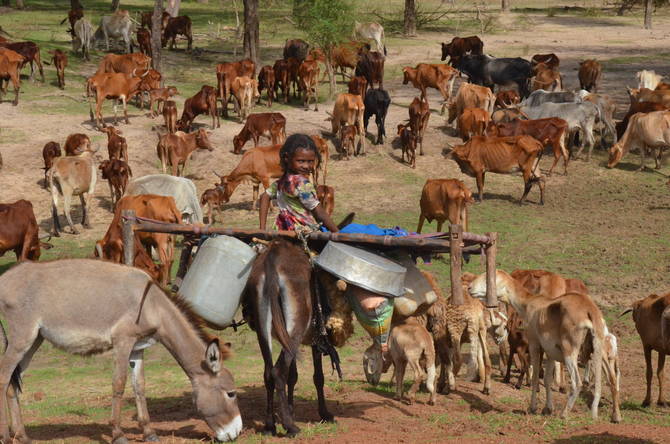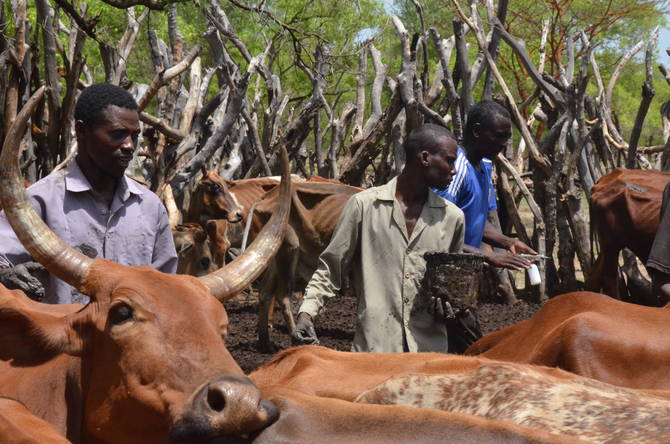Mobile pastoralism negotiated vaccination plans enhance landscape-level resilience in Sudan-South Sudan borders
The Abyei Administative Area is the dry-season grazing landscape of the Missiriya tribe, who spend the wet season in the southern parts of Kordofan in Sudan. In 2016, the area was relatively peaceful compared to previous dry seasons mainly due to a peace agreement established by the traditional leaders of both the Mysseriya (Sudan) and Dinka Ngok (South Sudan) ethnic groups. Nevertheless, security remains unpredictable because of the presence of armed groups in the area. FAO is implementing a conflict mitigation-livelihood support programme with both communities. The programme, which applies the Green Negotiated Territorial Development (GreeNTD) approach, engages with local stakeholders by providing vaccination and treatments of livestock to both communities; promoting an informed negotiation process over the access, use and management of natural resources; and using animal health interventions to increase trust and confidence amongst the two groups and facilitate joint actions.
The GreeNTD methodology follows a multistep process.
- Preparatory phase: Identifying the territorial perimeter of the concerned stakeholders, as well as their needs and aspirations.
- Phase I. Views: Gaining an understanding of the territory as a socio-ecological system, which involves identifying key agro-ecological issues, including the impacts of climate change, interrelations, power relations, and social, economic and productive dynamics; preparing a spatially delimited information system for the territory, which includes socio-economic, production and ecosystem data; reconstructing historical developments and future trends on the main topics of interest.
- Phase II. Horizons: Outlining coherent and feasible proposals for territorial development; setting scenarios to facilitate consensus; identifying dynamics that negatively affect the territory.
- Phase III. Negotiation: Seeking consensus for territorial development; creating roundtable negotiations involving all stakeholders (e.g. communities, local authorities, landowners and land administration institutions); and socially legitimizing the process.
- Phase IV. Stakeholders signing a Socio-Ecological Territorial Agreement, which provides the fundamental basis for the implementation of short-, medium- and long-term business plans; formalizing the rights and duties of each party; and creating an implementation platform composed of all stakeholders.
- Phase V. Monitoring and evaluating the activities undertaken.
Impacts
The intervention in Abyei has strengthened the resilience of agricultural livelihoods of vulnerable populations by reducing land disputes. Successes include:
- 25 Mysseryia community animal health workers in the common market at Noong (Central Abyei) were trained.
- Following the peace agreement between traditional leaders of the two communities, FAO was able to vaccinate 52 830 livestock (26 780 cattle and 26 050 sheep/goats) of the in 1 340 Mysseryia households. The South Sudan/Ngok Dinka officials who supported the vaccination felt safe and secure and were welcomed to the northern Abyei by the Mysseriya communities and the officials of the Abyei Joint Oversight Committee
- The dialogue mechanism has promoted reconciliation and intercommunal social cohesion, which has improved the sustainability of the stabilization process.
- The capacity development activities and the improved animal health have strengthened production, which has reduced land degradation and greenhouse gas emissions while improving income, food and nutrition security and resilience to climate change shocks.
Figure 1. Mysseryia girl belonging to pastoralist nomads community coming back to West Kordofan (Sudan) with her family along the Abyei box central migration corridor. They seasonally migrate to Abyei box in November, at the end of rain season, in search

Figure 2. Mysseryia community animal health workers vaccinating cattle in the northern area of Abyei with the support of FAO South Sudan team



